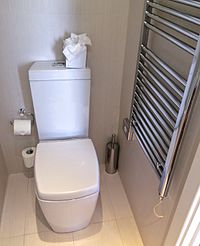
Photo from wikipedia
Abstract Ejectors usually act as thermal compressors to recover the superfluous water vapor in multi-effect desalination systems. However, the influences of wall conditions on the steam ejector performances were not… Click to show full abstract
Abstract Ejectors usually act as thermal compressors to recover the superfluous water vapor in multi-effect desalination systems. However, the influences of wall conditions on the steam ejector performances were not fully understood. To investigate the effects of the surface roughness and temperature on non-equilibrium condensation and entrainment performance in the steam ejector, a wet steam model was built by a computational fluid dynamics software. Simulation results indicate that the increase of roughness height reduces the ejector performance and attenuates the non-equilibrium condensation phenomenon significantly. Furthermore, as the wall temperature changes in the range of 30–150 °C, the ejector performance varies merely within 4%; however, condensation droplets which may cause erosion damage occurs on the internal surface when the wall has poor adiabatic properties. Therefore, the wall roughness and temperature should be fully considered to enhance the ejector performance and mitigate potential condensation on the wall.
Journal Title: Applied Thermal Engineering
Year Published: 2021
Link to full text (if available)
Share on Social Media: Sign Up to like & get
recommendations!